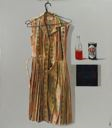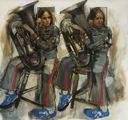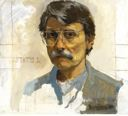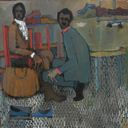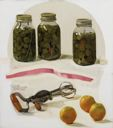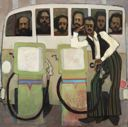Bruce Hixson Smith does not have an image.
Bruce Hixson Smith
(Salt Lake City, Utah, 1936 - )
Bruce Hixon Smith, a graduate of both Brigham Young University and the University of Utah, teaches drawing and painting at BYU. He currently lives in Springville with his family. While attending college, he studied with both Douglas Snow and Alvin Gittins. At that time, Bruce’s works leaned heavily toward non-objective art; however, after several often-frustrating years spent exploring abstract art, Smith shifted his focus. Currently, he is pursuing the spiritual in a style he calls academic objective realism. Bruce Smith relies heavily on repetition, often painting objects two or three times on the same canvas. He begins his work in a relaxed, uninhibited manner. He draws and redraws contour lines, making no attempt to cover up the first lines. These lines create a sense of movement, as if the person has paused momentarily or the fabric might move in the breeze. Smith brushes colors on thinly and briskly. He then moves from general to specific, usually concentrating on one focal point, building up colors, textures, and details, but leaving some areas gestural. Although painting is a private experience for Smith—visitors to his studio will find his easel facing away from the door and objects, that almost seem randomly distributed blocking the path—he deliberately leaves his paintings “open-ended, “ inviting viewers in. Smith’s use of symbols contributes to this open door sensation—the meanings of some of the symbols he uses are discernable but layered. Other symbols are obscure: a ribbon, a bottle of fruit, a piece of cloth. Smith says sometimes he doesn’t know the meaning of the symbols he uses. Not because he picks them randomly, but because he chooses the symbols intuitively, happy to let them remain undefined. He explains, “When they seem right, I put them in and purposely keep it a little bit vague, even to me; so they are not illustration, where everything is understandable. I want to have the possibility of going deeper—I prefer not to know exactly what they signify.” Smith says all his paintings are about art, which is in a constant state of flux. Modernism did away with the old attitudes and ideas about art, but now Modernism itself is over. Smith seeks to incorporate some of the older attitudes about art and still have his work retain some of the brand new things Modern Art tried to do, including being a means of “ditching” the old. Bruce has a real allegiance to what art was prior to Modernism, which he believes is common. What he doesn’t think is common is also having a feeling for Modernism. He is convinced that art before Modernism has value today, but that Modernism has elements of worth as well. The problem, he says, is to mix those qualities. The open-endedness of his works is certainly a Modernist trait; conversely, over the last few years, Smith has configured many of his paintings in ways that harken back to Italian religious works of the Renaissance. Those early multipaneled altarpieces consist of a principal central panel with secondary side and/or top panels, and a predella. The predella is a small strip of paintings which forms the lower edge of the altarpiece and usually has narrative scenes from the lives of the saints who are represented in the panels above, or a portrait of the person who commissioned the artwork. Some of Smith’s paintings have one smaller canvas below the main canvas, like an individual predella; others have a large central canvas with smaller ones above and below. And some, like The Street (Center of Snow), are themselves a series of paintings with another group below. Whatever the exact configuration, the allusion to Renaissance art is clear: and, like the symbols he uses, this reference gives depth to the artworks. But unlike David Hockney, who creates panoramic views, Bruce Smith uses multiple views and techniques like repetition to make his paintings offer us a wider view of ourselves. The artworks also invite us to ponder, to have “a growth of awareness. . . a refinement of self-understanding.” The painting Jacob and Leah, like all of Bruce Smith’s work, is a visual image that means more, and is more, visually than it ever will if we try to capture too closely that meaning in words.
(Salt Lake City, Utah, 1936 - )
Bruce Hixon Smith, a graduate of both Brigham Young University and the University of Utah, teaches drawing and painting at BYU. He currently lives in Springville with his family. While attending college, he studied with both Douglas Snow and Alvin Gittins. At that time, Bruce’s works leaned heavily toward non-objective art; however, after several often-frustrating years spent exploring abstract art, Smith shifted his focus. Currently, he is pursuing the spiritual in a style he calls academic objective realism. Bruce Smith relies heavily on repetition, often painting objects two or three times on the same canvas. He begins his work in a relaxed, uninhibited manner. He draws and redraws contour lines, making no attempt to cover up the first lines. These lines create a sense of movement, as if the person has paused momentarily or the fabric might move in the breeze. Smith brushes colors on thinly and briskly. He then moves from general to specific, usually concentrating on one focal point, building up colors, textures, and details, but leaving some areas gestural. Although painting is a private experience for Smith—visitors to his studio will find his easel facing away from the door and objects, that almost seem randomly distributed blocking the path—he deliberately leaves his paintings “open-ended, “ inviting viewers in. Smith’s use of symbols contributes to this open door sensation—the meanings of some of the symbols he uses are discernable but layered. Other symbols are obscure: a ribbon, a bottle of fruit, a piece of cloth. Smith says sometimes he doesn’t know the meaning of the symbols he uses. Not because he picks them randomly, but because he chooses the symbols intuitively, happy to let them remain undefined. He explains, “When they seem right, I put them in and purposely keep it a little bit vague, even to me; so they are not illustration, where everything is understandable. I want to have the possibility of going deeper—I prefer not to know exactly what they signify.” Smith says all his paintings are about art, which is in a constant state of flux. Modernism did away with the old attitudes and ideas about art, but now Modernism itself is over. Smith seeks to incorporate some of the older attitudes about art and still have his work retain some of the brand new things Modern Art tried to do, including being a means of “ditching” the old. Bruce has a real allegiance to what art was prior to Modernism, which he believes is common. What he doesn’t think is common is also having a feeling for Modernism. He is convinced that art before Modernism has value today, but that Modernism has elements of worth as well. The problem, he says, is to mix those qualities. The open-endedness of his works is certainly a Modernist trait; conversely, over the last few years, Smith has configured many of his paintings in ways that harken back to Italian religious works of the Renaissance. Those early multipaneled altarpieces consist of a principal central panel with secondary side and/or top panels, and a predella. The predella is a small strip of paintings which forms the lower edge of the altarpiece and usually has narrative scenes from the lives of the saints who are represented in the panels above, or a portrait of the person who commissioned the artwork. Some of Smith’s paintings have one smaller canvas below the main canvas, like an individual predella; others have a large central canvas with smaller ones above and below. And some, like The Street (Center of Snow), are themselves a series of paintings with another group below. Whatever the exact configuration, the allusion to Renaissance art is clear: and, like the symbols he uses, this reference gives depth to the artworks. But unlike David Hockney, who creates panoramic views, Bruce Smith uses multiple views and techniques like repetition to make his paintings offer us a wider view of ourselves. The artworks also invite us to ponder, to have “a growth of awareness. . . a refinement of self-understanding.” The painting Jacob and Leah, like all of Bruce Smith’s work, is a visual image that means more, and is more, visually than it ever will if we try to capture too closely that meaning in words.
